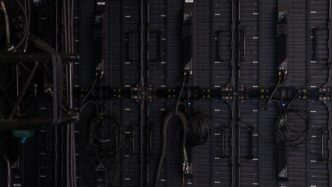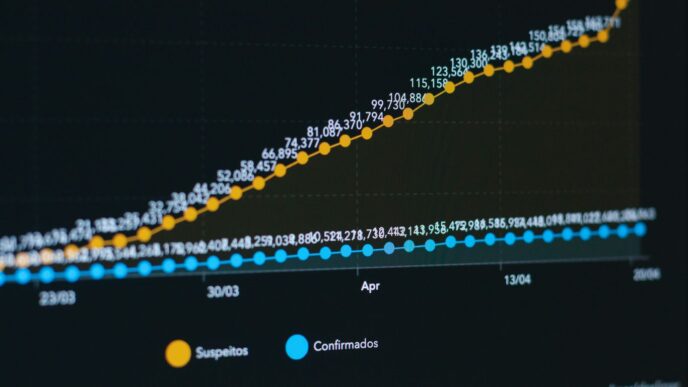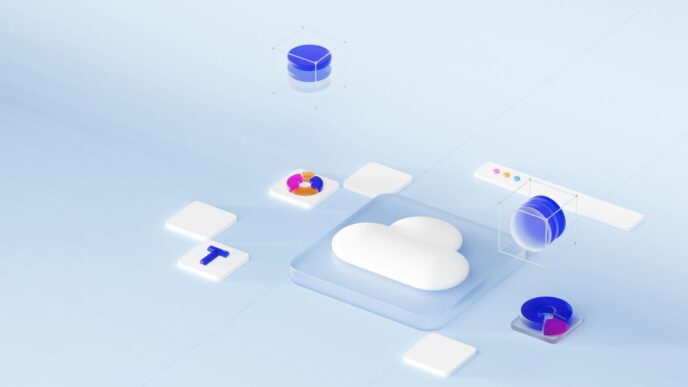Understanding Cluster Computing Fundamentals

So, what exactly is this ‘cluster computing’ everyone’s talking about? Think of it like a team of computers working together, instead of just one doing all the heavy lifting. It’s about pooling the power of many machines to tackle problems that would be too big or take too long for a single computer.
What Is Cluster Computing?
Basically, cluster computing involves linking several individual computers, often called ‘nodes’, so they can act as one unified system. Each node has its own processor, memory, and storage. When a big job comes along, it gets broken down into smaller pieces, and these pieces are sent out to different nodes to be worked on simultaneously. It’s a bit like having a group of friends all help you move furniture instead of trying to do it all yourself – much faster and less back-breaking!
Importance of Cluster Computing
Why bother with all this setup? Well, the main reason is performance. For really demanding tasks, like complex scientific simulations or analyzing massive amounts of data, a single computer just can’t keep up. Cluster computing lets us:
- Process information much faster: By dividing the work, tasks get done in a fraction of the time.
- Handle bigger problems: We can take on computational challenges that were previously impossible.
- Keep things running: If one computer in the cluster has a hiccup, the others can often pick up the slack, meaning less downtime.
Cluster Computing Versus Traditional Computing
It’s pretty different from your average desktop or laptop. Here’s a quick rundown:
| Feature | Cluster Computing | Traditional Computing |
|---|---|---|
| Processing | Multiple computers (nodes) work in parallel. | Single computer works sequentially. |
| Speed | Much faster for complex, divisible tasks. | Slower for demanding, large-scale jobs. |
| Reliability | Higher; if one node fails, others can continue. | Lower; single point of failure. |
| Scalability | Easy to add more nodes to increase power. | Limited; upgrading a single machine. |
| Typical Use | Scientific research, big data, AI, simulations. | Everyday tasks, office work, browsing. |
So, while your laptop is great for emails and browsing, a cluster is built for the heavy-duty computational lifting.
Key Components Powering Cluster Systems
So, you’ve got this idea of a cluster, right? It’s not just a bunch of computers sitting around. There are some specific parts that make the whole thing tick. Think of it like building a team – you need different players with different jobs.
Nodes and Master Nodes
First off, you have the ‘nodes’. These are basically individual computers, each with its own brain (CPU), memory, and a place to store stuff (storage). They’re the workhorses. In a cluster, they all team up to tackle big jobs. But someone’s gotta be in charge, right? That’s where the ‘master node’ comes in. It’s like the team captain. It doesn’t do all the heavy lifting itself, but it tells the other nodes what to do, keeps track of everything, and makes sure the work gets done smoothly. It’s the central point for managing the whole operation.
Interconnects and Networking
Now, how do all these nodes talk to each other? That’s where ‘interconnects’ and networking come in. Imagine a busy office – you need good communication lines. In a cluster, these are super-fast connections. They let the nodes swap information back and forth really quickly. This is super important because if one node needs data from another, or if they’re working on pieces of the same problem, they need to share that info without a big delay. Slow communication means slow work, and that defeats the whole purpose of a cluster.
Distributed File Systems
Finally, there’s the ‘distributed file system’. Think about all the data a cluster might need to process. Instead of storing it all on one computer, a distributed file system spreads it out across multiple nodes. This means any node can get to the data it needs, no matter where it’s physically stored. It’s like having a shared library where everyone can access books from different shelves without having to go to a central archive every time. This is a big deal for jobs that involve massive amounts of data, like analyzing huge datasets or running complex simulations.
Exploring Different Types of Clusters
So, we’ve talked about what cluster computing is and why it’s a big deal. Now, let’s get into the nitty-gritty of the different kinds of clusters out there. It’s not just one-size-fits-all, you know? Different jobs need different tools, and that’s where these various cluster types come in.
High-Performance Computing Clusters
These are the speed demons. Think of HPC clusters as a bunch of powerful computers working together on really tough problems. They’re built for tasks that need a ton of processing power, like scientific simulations, complex modeling, or crunching massive amounts of data for research. The main goal here is raw speed and getting answers to complicated questions as fast as possible. They often use specialized, high-speed networks to make sure all the nodes can talk to each other without delay.
High-Availability Clusters
When downtime is just not an option, you bring in high-availability (HA) clusters. These are designed to keep services running even if one of the computers in the cluster fails. How do they do it? Usually, you have at least two machines, and if one goes down, another one immediately takes over its workload. It’s like having a backup ready to jump in. This is super important for things like websites, databases, or any application where constant access is key. The whole point is to minimize interruptions for users.
Load Balancing Clusters
Imagine a popular website getting tons of visitors all at once. A single server would probably crash. Load balancing clusters spread that incoming traffic across multiple servers. So, instead of one machine getting hammered, the work is shared. This makes sure that no single server gets overloaded, leading to faster response times and a better experience for everyone. It’s all about distributing the workload evenly.
Data Clusters
These clusters are all about managing and processing large volumes of data. They’re often used in big data analytics, where you need to store, access, and analyze huge datasets. Think about grouping similar data points together to find patterns or trends. Algorithms are used to sort data into ‘clusters’ based on shared characteristics. This helps make sense of complex information and can be used for things like customer segmentation or identifying anomalies. It’s a bit like sorting a giant pile of LEGO bricks by color and size so you can find what you need faster.
Benefits and Drawbacks of Cluster Computing
So, why bother with cluster computing? Well, it’s got some pretty sweet advantages, but like anything, it’s not all sunshine and rainbows. Let’s break it down.
Enhanced Performance and Scalability
This is the big one. Imagine you’ve got a massive task, like crunching numbers for a scientific simulation or analyzing a huge pile of data. Instead of one computer chugging away slowly, a cluster lets you split that job up and have dozens, hundreds, or even thousands of computers work on it at the same time. This parallel processing means you get results way, way faster. Plus, if your needs grow, you can just add more computers (nodes) to the cluster. It’s like adding more lanes to a highway when traffic gets heavy – keeps things moving smoothly.
Fault Tolerance and Resource Utilization
Another major plus is reliability. If one computer in the cluster decides to take an unscheduled nap (you know, crashes), the others can pick up its slack. This is called fault tolerance, and it’s super important for systems that absolutely cannot go down, like financial trading platforms or emergency response systems. It means your work doesn’t stop just because one piece of hardware hiccups. On top of that, clusters are really good at using all the computer power you’ve paid for. Instead of having a bunch of idle machines, tasks are spread out, so everything is working hard. It’s like having a well-organized team where everyone has a job to do.
Implementation Costs and Complexity
Now for the not-so-fun part. Setting up a cluster isn’t like plugging in a new printer. It requires specialized knowledge to get all those computers talking to each other efficiently and to manage them effectively. This means you often need skilled IT staff, which can add up. The hardware itself might be made of standard parts, which is cheaper than a single super-powerful machine, but the overall cost of getting it all running and keeping it running can be significant. Think of it like building a custom race car versus buying a regular sedan – the race car is faster, but way more complicated and expensive to build and maintain.
Software Compatibility and Security Concerns
Getting all your software to play nicely across a bunch of different computers can be a headache. Sometimes, applications designed for a single machine don’t automatically work well in a distributed environment. You might need to tweak them or find special versions. And then there’s security. When your data is spread across many machines, it can create more points of entry for potential threats. You have to be extra careful about protecting each node and the network connecting them. It’s like having your valuables stored in multiple safes instead of just one – you need to secure each safe individually, and the pathways between them.
Real-World Applications of Cluster Computing
So, where does all this cluster computing power actually get used? It’s not just for theoretical stuff; it’s out there, making big things happen across a bunch of different fields. Think about it – when you need to crunch a ton of numbers or run a super complex simulation, a single computer just isn’t going to cut it. That’s where clusters shine.
Scientific Research and Simulations
Scientists are constantly pushing the boundaries of what we know, and often, that involves modeling incredibly complex systems. Whether it’s figuring out how molecules interact for drug discovery, simulating the birth of a star, or understanding the intricate workings of the human genome, clusters are the workhorses. They let researchers run these massive simulations much faster than before. This means quicker insights and potentially faster breakthroughs in medicine, materials science, and physics. It’s like having a super-powered virtual lab.
Big Data Analytics and AI
We’re generating more data than ever, and making sense of it all is a huge challenge. Clusters are absolutely vital for big data analytics. They can process enormous datasets to find patterns, trends, and insights that would be impossible to spot otherwise. This is a big deal for businesses trying to understand their customers, for financial institutions predicting market shifts, and for healthcare providers analyzing patient data. Similarly, training sophisticated Artificial Intelligence and Machine Learning models requires immense computational muscle. Clusters provide that power, speeding up the development of AI that can recognize images, understand language, and much more.
Weather Forecasting and Bioinformatics
Accurate weather forecasts are critical for everything from planning your weekend to managing disaster response. Running detailed atmospheric models takes a massive amount of computing power, and clusters are the backbone of modern meteorological centers. They allow for more precise predictions over longer periods. In the realm of bioinformatics, analyzing DNA sequences, protein structures, and other biological data is incredibly computationally intensive. Clusters help researchers in this field accelerate their work, leading to advancements in understanding diseases and developing new treatments.
Financial Modeling and Entertainment
The financial world moves at lightning speed, and making informed decisions requires sophisticated modeling. Clusters are used for everything from risk assessment and algorithmic trading to fraud detection. They enable financial analysts to run complex scenarios and get results quickly, which is key in such a dynamic environment. And on the entertainment side? Think about the stunning visual effects in blockbuster movies or the detailed animations in video games. Rendering these complex graphics requires immense processing power, and clusters are often employed to get the job done efficiently, allowing for more creative freedom and faster production cycles.
The Evolving Landscape of Cluster Computing
Cluster computing isn’t just sitting still; it’s constantly changing, getting better with new tech. Think about how quantum computing is starting to pop up. It promises to make calculations ridiculously fast, way faster than what we have now. This could mean solving problems that are currently impossible for even the biggest clusters.
Then there’s the whole edge computing thing. Instead of sending all data back to a central cluster, we can do some processing right where the data is created. This is super useful for things that need quick reactions, like self-driving cars or factory robots. It cuts down on delays.
Managing these big systems can get complicated, right? So, automation is becoming a big deal. Machine learning is helping to figure out the best way to use all the computers in a cluster, making sure no power is wasted and tasks get done efficiently. It’s like having a smart assistant for your supercomputer.
And for folks who don’t want to buy and maintain their own massive hardware, cloud services are making cluster computing more accessible. You can rent the power you need, when you need it. This opens up possibilities for smaller companies and researchers who couldn’t afford it before.
Of course, with all this power comes challenges. We’re talking about using a lot of electricity, so making clusters more energy-efficient is a big focus. And as data gets spread out more, keeping it all secure is more important than ever. So, expect to see more work on "green" computing and better ways to protect data.
Here’s a quick look at how things are shaping up:
- Quantum Computing Integration: Expect hybrid systems where quantum processors tackle specific, hard problems alongside traditional cluster nodes.
- Edge and Fog Computing Synergy: Processing data closer to the source for real-time applications, reducing reliance on central clusters for immediate tasks.
- AI-Driven Management: Machine learning algorithms will increasingly automate resource allocation, fault detection, and performance tuning.
- Cloud-Native Clusters: More services will be built specifically for cloud environments, simplifying deployment and scaling.
- Focus on Sustainability: Innovations in hardware and software to reduce the energy footprint of large-scale computing.
Wrapping It Up
So, we’ve gone through what cluster computing is all about, why it’s a big deal, and how it actually works. It’s pretty clear that using a bunch of computers together can get a lot of heavy lifting done way faster than just one machine. From crunching huge amounts of data for science to making sure websites don’t crash when everyone visits at once, clusters are quietly powering a lot of the tech we use every day. While setting them up can be a bit tricky and you have to watch out for security, the benefits like speed and being able to add more power as needed are huge. As technology keeps moving forward, especially with things like AI and cloud services, cluster computing is only going to become more important. It’s a solid way to tackle really big problems, and it’s definitely here to stay.














